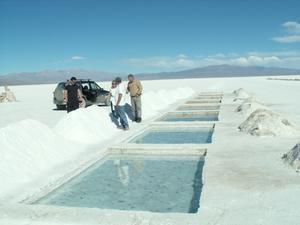Advertisement
Published: June 13th 2005

 Salinas Grande
Salinas Grande
Extracting the saltEarly yesterday morning we departed Salta on a guided tour, leaving behind civillisation. Original plans of taking the train to the clouds trip was cancelled due to the train engine requiring maintenance. Instead we set off along the same route by 4x4 vehicle up the Quebrada del Toro. The road took us through rugged terrain with the Andes towering on both sides. The rock is sedimentary up to 2500m and then becomes granite based. It is rich in minerals and leaching leaves a diverse and picturesque array of colours on the hill side... red, yellow, green, and white. Passing by many small villages, locals make a living by growing potatoes, onion and corn. They also have small herds of goat and llama. The electricity is solar powered. Cardon Cacti grows up 3500m, above this it doesn´t survive. The cacti only grows 8-10cm/year, but the wood when dried is extremely strong. It is used for roofing and other things.
By lunch time we had reached the Andean Plateau @ 4200m where we stopped at San Antonio. The oxygen in the air is 25% less than normal here and the temp drops to -10deg at night. People in this town work at

 Salinas Grande
Salinas Grande
Solar kitchen. The workers boil the kettle.the nearby copper mines. The whole landscape is barren and desolate.
From here it was a pretty tedious drive across to the Salinas Grandes - the largest salt flats in Argentina @3800m. The bright white plain against the clear blue sky is impressive. Workers here who manually extract the salt earn 35pesos per 1000kg salt...about 2 days work for NZ$17!!! There´s a restuarant here made entirely from salt, the exterior, tables, chairs etc.
From here we dropped down the valley 2000m in 20k´s, and stopped at Purmamarca for the night. This town was home to the famous Indian Chief Viltipoco. The backdrop to this town is the impressive 7 colours hill. The women here sell their handicrafts at the centre markets, mainly llama hair clothing, poncho´s, rugs and other nick-knacks.
Day 2 was a later start and we headed north up the Quebrada de Humahuaca. We passed through many small towns en route to Humahuaca @3000m. This town is home to the 1st church built in Argentina. Other interesting stops included Tilcara where we viewd ancient pre-hispanic buildings, and the cemetery of Maimara. We finished up in San Salvador de Jujuy. The guide on day 2 was

 Purmamarca
Purmamarca
Nesttled in the valleyvery interesting to talk to, and we got a good insight to the political and social problems of Argentina which has resulted from their economic crash in 2000.
Due to the political unrest in Bolivia, we have altered plans, and tomorrow will catch a bus to Chile.
Advertisement
Tot: 0.289s; Tpl: 0.011s; cc: 15; qc: 57; dbt: 0.0572s; 1; m:domysql w:travelblog (10.17.0.13); sld: 1;
; mem: 1.1mb

 Salinas Grande
Salinas Grande
 Salinas Grande
Salinas Grande
 Purmamarca
Purmamarca







anonymous
non-member comment
amazing - ann